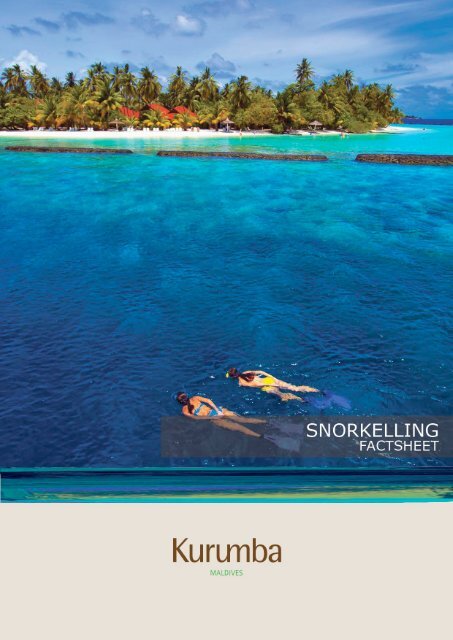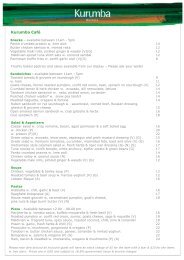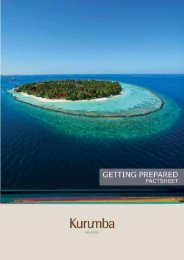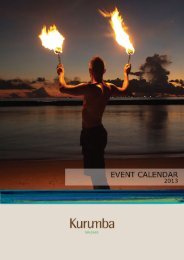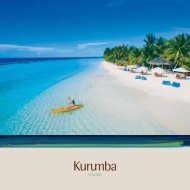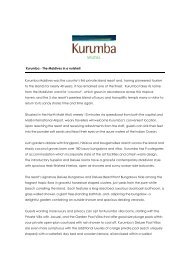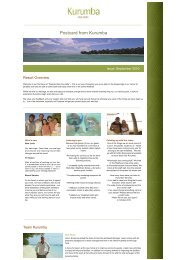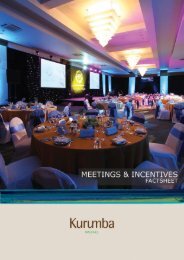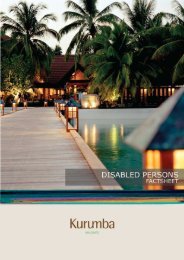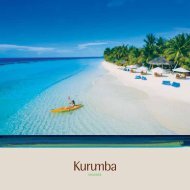SNORKELING FACT SHEET - Kurumba Maldives
SNORKELING FACT SHEET - Kurumba Maldives
SNORKELING FACT SHEET - Kurumba Maldives
Create successful ePaper yourself
Turn your PDF publications into a flip-book with our unique Google optimized e-Paper software.
SNORKELLING<br />
SNORKELLING IN THE MALDIVES<br />
The <strong>Maldives</strong> covers an area of 90,000 sq. km and lies in the middle of the Indian Ocean. Its 1196 coral islands are<br />
grouped into 26 Atolls. Most of the islands are surrounded by a large ring-shaped coral reef, while others share one<br />
common reef with just one or two islands. It protects the islands inside the atoll against high waves and rough sea.<br />
Water temperature on the shallower, down to 30 metres reef areas varies from only 26 to 30 degrees Celsius<br />
throughout the year. Inside the shallow lagoon the water temperature may reach slightly higher levels.<br />
The abundance of marine life is a source of attraction for not only divers but also for those passionate about<br />
snorkelling. The waters around <strong>Kurumba</strong> are home to more than 1200 species of fish and other marine creatures as<br />
well as more than 1000 coral species and other reef invertebrates that create the reef on which they live.<br />
What makes <strong>Maldives</strong> special for those snorkelling is the presence of rare marine life species like the giant Napoleon<br />
Wrasse as well as turtles, eels, sharks and many many more.<br />
LEARNING TO SNORKEL<br />
For those who already have the ability to swim comfortably, progressing on to snorkelling is a relatively easy next<br />
step. The best place to start your snorkelling adventure is in the shallow and calm lagoon waters where you can<br />
comfortably set your feet down on sand but yet still be captivated by colourful marine life. For those less comfortable<br />
with swimming a lesson with and instructor and a flotation device to start with is the best plan. Most of all remember<br />
snorkelling is about moving slowly and calmly and allowing the marine life to go about their daily lives.<br />
SNORKELLING SAFETY<br />
The azure waters surrounding <strong>Kurumba</strong> just beg to be explored. However, when snorkelling there are some things<br />
you should know. The most important safety tip while snorkelling is to choose a buddy who you are comfortable with<br />
and stay within sight of each other while you are out. It is not recommended to snorkel alone. Also you should only<br />
undertake snorkelling if you are a confident swimmer.<br />
Here are some helpful hints:<br />
• Stay close to shore.<br />
• Be aware of strong currents, boat traffic and shallow areas. The team at the Water Sports center can help you with<br />
this information<br />
• Retain your energy. To avoid exhaustion consider snorkelling with a flotation device of some sort.<br />
• Snorkelling should be relaxing, so slow and gentle is recommended.<br />
• Do not touch marine life. Be aware of the seabed and proximity of coral, and be careful snorkelling when the tide<br />
is going out as coral can severely injure a snorkeler, as can snorkelers severely injure the live coral.<br />
• Check tidal movement and wave conditions before entering the water<br />
• Please ask the Water Sports Team for more information about snorkelling safety.<br />
Don’t worry if you haven’t brought snorkelling equipment with you, we have sets available for guest use in the Water<br />
Sports Centre. Drop by and see the staff between 8am and 6pm.
SNORKELLING<br />
ECO FRIENDLY SNORKELLING<br />
Coral reefs are among the world’s most spectacular, and vitally important, habitats and snorkelling is an excellent<br />
way to explore them. As reefs face an increasingly uncertain future, snorkelers and other coral reef visitors can play<br />
an important role in helping to protect these fragile environments. Follow these simple guidelines to help protect the<br />
coral reefs you visit.<br />
! Never touch the coral. They are living animals and even slight contact can harm them and some corals can sting/cut<br />
you.<br />
! Corals need sun to live and the sunscreen we use can kill coral. If possible wear UV protective clothing instead.<br />
• Select points of entry and exit to avoid walking on or bumping into corals. Be aware of tidal movement and choose<br />
to snorkel during mid to high tides.<br />
! Maintain a comfortable distance from the reef so that you’re certain you can avoid contact.<br />
! Know where your fins are at all times and try not to kick up sand which can smother the coral polyps.<br />
! Stay horizontal in the water while you’re near or above the reef.<br />
! Learn to swim without using yours arms.<br />
! Move slowly in the water — relax and take your time.<br />
Snorkelling pros know the real way to enjoy the beauty of the reef is to slow down, relax and watch as reef creatures<br />
go about their daily lives undisturbed.<br />
KURUMBA SNORKELLING MAP
SNORKELLING<br />
SNORKELLING SITES<br />
CORAL GARDEN<br />
Depth<br />
: 1 to 2 metres, any tide depth<br />
Water Conditions : Calm, gentle current, 27 - 32°C<br />
Sea Floor<br />
Experience Level<br />
: Mostly sand with scattered coral stands<br />
: Beginner to intermediate<br />
This is the perfect spot for beginner snorkelers. In the calm, shallow<br />
lagoon waters there are many small and juvenile fish that hover over the<br />
bottom looking for food. Heading out from the shore you will be spotted by<br />
the curious and almost transparent pursemouths and pompanos. Once you<br />
are over the coral outcrops you may be lucky enough to spot juvenile<br />
pufferfish hovering, anemone fish hiding, damsel fish protecting their<br />
homes, small butterfly fishing fluttering around and busy goatfish digging<br />
through the sand. Many reef fish species use the lagoon as a nursery for<br />
their young so keep an eye out and you could spot many interesting<br />
things.<br />
SHARK POINT<br />
Depth<br />
Water Conditions<br />
Sea Floor<br />
Experience Level<br />
: 1 to 2 metres on flat, drop off to 30 metres,<br />
suitable at mid to high tide<br />
: Weather dependent, can be choppy, variable<br />
current, 27 - 30°C<br />
: Sand flats with a coral edged drop off<br />
: Advanced snorkelers, strong swimmers.<br />
Shark lovers galore, this point of the reef has long been known to be home<br />
to many adult black tip reef sharks. The sand flats are shallow at low tide<br />
and can experience some wave action so it is recommended to head out at<br />
a narrower part of the reef and swim around to the point. Any way you go<br />
the treasures of this area do require quite a long swim so only attempt this<br />
area if you are a strong swimmer and the weather is calm with low seas.<br />
This must be snorkeled with a buddy. As well as sharks there are many<br />
other marine species to discover.<br />
THE WALL<br />
Depth<br />
Water Conditions<br />
Sea Floor<br />
Experience Level<br />
: 1 to 2 metres on flat, drop off to 30 metres,<br />
suitable at mid to high tide<br />
: Weather dependent, can be choppy, gentle to<br />
medium current<br />
: Mostly sand with scattered coral stands<br />
: Beginner to intermediate<br />
This part of the reef offers a slightly larger flat which heads out to a steep<br />
reef wall. This area is home to a huge group of schooling bannerfish, many<br />
wrasse species as well as a great deal of corals. You are likely to see large<br />
trevally such as the Giant and Blue-fin species as well as a multitude of<br />
snapper and sweetlips. As you head out over the sand flat keep your eye<br />
peeled for feathertail or blue spotted sting rays that will bury themselves<br />
down into the sand as you approach.
SNORKELLING<br />
SALLY’S PATCH<br />
Depth<br />
Water Conditions<br />
Sea Floor<br />
Experience Level<br />
: 1 to 2 metres on flat, drop off to 30 metres,<br />
suitable at mid to high tide<br />
: Weather dependent, can be choppy, gentle to<br />
medium current, 27 - 30°C<br />
: Coral stands on the reef, flat with a steep drop<br />
: Intermediate to Advanced<br />
This is arguably the most interesting part of <strong>Kurumba</strong>’s reef to investigate.<br />
Head out over Coral Garden to a break in the wall around 5 metres down<br />
from the salt water intake tower in the water and keep your eye peeled for<br />
an occasional turtle sitting on the reef flat. Once you are near the drop off<br />
turn to the right and make your way slowly to the tower, stopping off to<br />
check out the large coral boulder about 2 metres back. Underneath the<br />
tower you can spot a number of snapper, sweetlips, wrasse and a huge<br />
porcupine fish named Priscilla. Peer into the depths to see a large school of<br />
batfish and if you are lucky a white tip reef shark. Meander on your way to<br />
spot many other fish including Sally the Shark who looks after and patrols<br />
this part of the reef. The very fortunate have an opportunity to spot 4<br />
cuttlefish who occupy the waters near the surface.<br />
HOUSE REEF / EELSVILLE<br />
Depth<br />
Water Conditions<br />
Sea Floor<br />
Experience Level<br />
: 1 to 2 metres on flat, drop off to 30 metres,<br />
suitable at any tide from the service jetty<br />
: Weather dependent, can be choppy, variable<br />
current with some surge at the temps,<br />
27 - 30°C<br />
: Mostly sand with scattered coral stands<br />
: Intermediate to Advanced<br />
Heading to the right from the jetty steps is a great spot for watching the<br />
multitudes of blue triggerfish swimming about busily. Head left around the<br />
jetty and you will discover remoras waiting patiently for food scraps and<br />
large fish species also waiting their turn. Peering down into the coral and<br />
rock wall of the jetty and harbour wall you will have the chance to spot<br />
one of the many moray eels that have made their home here. Interestingly<br />
you can often see 2 or more different species all living in the same hole.<br />
PARROT CAGE<br />
Depth<br />
Water Conditions<br />
Sea Floor<br />
Experience Level<br />
: 1 to 2 metres on flat, drop off to 70 metres,<br />
mid to high tide<br />
: Weather dependent, can be choppy,<br />
variable current, 27 - 32°C<br />
: Sand with anemones and coral rubble<br />
: Beginner to Advanced<br />
This part of the reef has less live coral due to boat wash which makes it<br />
the perfect place for parrot fish spotting. There are hundreds of them<br />
ranging in size up to 80cm in length, all busily recycling dead coral in sand<br />
for our beaches. Watch as they nibble off the coral rubble, filter out the<br />
goodies and swim off distributing sand as the go. This is also the best spot<br />
for Nemo watching as there are many anemones playing home to these<br />
much loved creatures. When you have had your fill head inside the lagoon<br />
flat and hover slowly over the sand to spot reef pipe fish, a relative of the<br />
sea horse, sitting on the sand. Look out for a pregnant male who carries<br />
the eggs in pouches on his side.
SNORKELLING<br />
This is a guide only, as we are dealing with wild marine creatures not all of the above mentioned species may been<br />
seen at all times. Also although most of the marine life around <strong>Kurumba</strong> is harmless if undisturbed some creatures<br />
may defend themselves, their family or their home so give the creatures their space and swim away with you fins<br />
towards the animal if any fish displays aggressive behaviors. Do not under any circumstances attempt to pick up or<br />
catch any animal as it may result in risk to yourself.<br />
CONDITIONS<br />
There are inherent risks with snorkelling and you should be physically fit with a good swimming ability. This fact sheet<br />
is a reference guide only and if you are snorkelling in <strong>Kurumba</strong> <strong>Maldives</strong> or on one of its associated companies tours,<br />
you are required to sign and agree to the terms and conditions on the disclaimer located at the Water Sports center.


